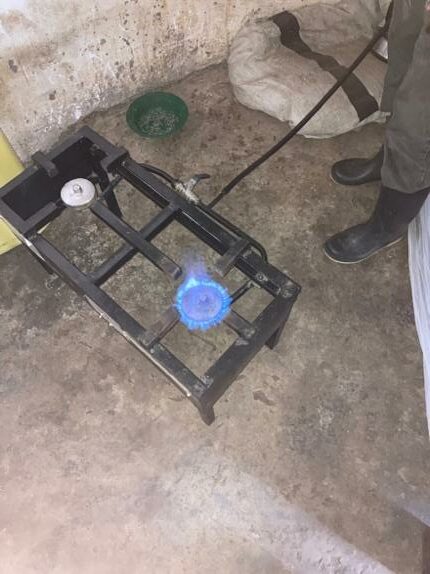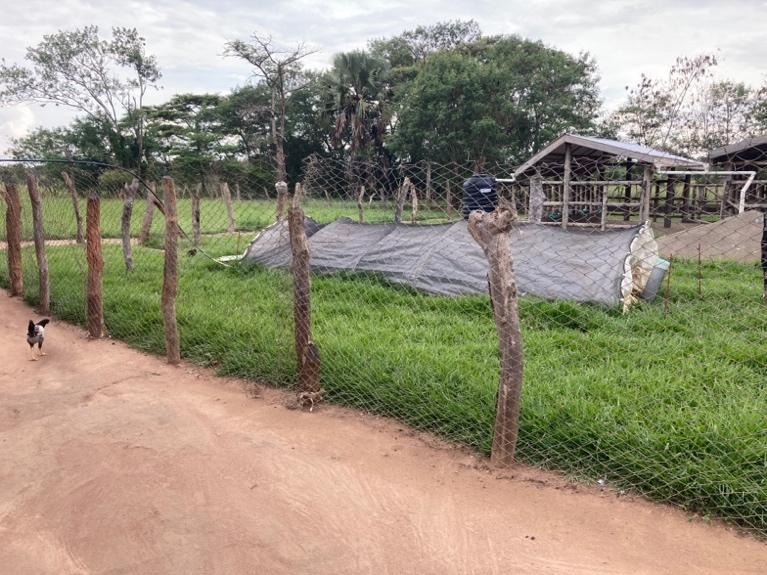The Initial Concept
I joined Father Joseph Okumu in the realization of the biogas plant when I came for my summer holidays with him and his community in Paimol. Paimol is a remote area of the country’s northern region and is 450 kilometers north of the capital city Kampala. It has become famous for the martyrdom of two young Acholi catechists Blessed Daudi Okelo and Jildo Irwa killed in 1918 on account of their faith and consequently beatified by Pope Saint John Paul II in 2002.
As Father Joe was representative of the Archdiocese of Gulu in the beatification process of the two, he was appointed Rector of the Shrine to build on the site of martyrdom in 2013. Father Joe, who completed his studies in Philosophical Anthropology in Rome in 1994, found his appointment to Paimol propitious as he not only sought to develop the site into one of religious
pilgrimage, but also to make the lives of the local people better thanks to the martyrs who paved the way.
Before coming to Uganda, I had written to him about my excitement for the opportunity to be with him and the Acholi people, fully immersing myself in the difficulties that people face, and hopefully generating solutions that could affect their lives for the better. I then joined Father Joe in his venture of positive change by sitting and listening to him and he to me as we mutually narrated all that went on in our minds, with a focus on renewable energy solutions in Paimol. From this discussion grew the original idea of Father Joe’s in which he imagined a way that the waste from the local primary school could be used to light the building itself. This idea transformed when Father Joe heard of a biogas system that a local farmer in Kitgum had installed at his home to help him cook. A visit was paid to the farmer’s home who graciously showed us his system. It consisted of an inlet for the cow waste mixed with water, an outlet for odorless fertilizer that can be applied to a farmer’s crops, and an outlet at the top leading to his home where the biogas could be used to cook directly on his gas stove. Without much knowledge of the system or biogas and how it worked, it was incredible to see that with the work of the sun, cow waste could be turned into usable cooking gas. It also appeared to be a very exciting
opportunity for the people of Paimol. After living among these people for a few weeks, I had begun to understand the means with which these people cook and the difficulties they face as a result.



Life in Paimol
The people of Paimol are peasant farmers who live in small, grass-thatched huts like the one shown above, where they cook, sleep, and spend time with family. In general, the people of this community cook with charcoal or firewood in their homes. Charcoal is expensive, difficult to light, and hard to find in Paimol. Firewood on the other hand is cheaper, easy to light, and by traveling long distances, 5-10 kilometers, one can collect firewood to cook. This places a huge burden on the women of the community as they are the ones spending the time and energy going out to buy or look for fuel, as well as preparing and cooking the meals that feed their families. More significantly however, are the extreme health risks associated with cooking indoors with charcoal or firewood. In some cases, old or useless plastics are used to light charcoal fires, posing a huge biological hazard to women and children cooking or around the fire. The smoke that is released by burning these fuels, especially firewood, causes respiratory and long-term eye health issues, and globally is the impetus for over four million premature deaths each year. It also creates an extremely dirty and ashy home, runs the risk for catching the grass roof of the home on fire, and can also cause burns on those around the fire.
While also being farmers, they keep cattle which are used occasionally for milk and meat, but for the most part are used for plowing, as a source of money, and for their waste. Some of this waste is used as fertilizer on their crops or as a sort for mortar for their houses, but much of it is discarded or left in the coral where it accumulates, making it place where cattle can catch disease. This uncleanliness can also pose health issues to the cattle keepers themselves.
With this in mind, a future was imagined where the people of Paimol and similar rural communities could repurpose this waste to forego all of the difficulties associated with using firewood and charcoal as fuel sources, use a constantly available clean energy source in their homes, and apply this purified fertilizer on their crops. This would incite innovation and entrepreneurship among these people and allow for the community to take initiative, giving their livestock enhanced value in an increasingly technological world, and returning the time for communal and family life expended fetching and preparing firewood.
Biogas Production
Understanding the scientific process of how biogas is formed is important in understanding how the system itself functions as well as its applications. Within the cow waste are bacteria that when placed in a very hot environment without oxygen digest the waste, creating the byproducts of gas and slurry, or fertilizer. This is called anaerobic digestion. The gas that is released contains methane, carbon dioxide, and small amounts of hydrogen sulfide and water vapor. Due to the fact that methane gas has a very high energy density, meaning when it is burned, a large amount of energy is released in the form of heat, one can cook with the biogas just like Liquid Petroleum Gas or LPG. Cooking with biogas is also safer, has relatively low carbon emissions, has no smell, releases no smoke, and has a pocket-friendly cost compared to that of expensive LPG or natural gas. The fertilizer or bio-slurry can be used as a significantly better substitute for manure or other natural fertilizers used on crops and can also repel harmful pests due to its concentration of nitrogen.

Potential Downsides
There are some risks or disadvantages to biogas production, however, that must be addressed. One disadvantage is that biogas can only be produced at high temperatures, 20 °C or higher, but this is not a problem here in the warm climate of Uganda. It also has risks of explosion if a flame is near the digester bag where the gas is stored, so safety must be employed in this respect. Biogas contains carbon dioxide and hydrogen sulfide which can be very dangerous in poorly ventilated environments, a problem that is not prevalent in many of the buildings here in Paimol. The price of installation is also relatively high, with the cost ranging between around 1,000,000 UGX and 7,500,000 UGX for at-home systems. The main issues with biogas, however, is its inability to be scaled for scattered populations as it is difficult to refine and store, and its production is not very efficient. But, on a rural community level, this is an ideal way to access clean fuel with the risk level associated being extremely low
A Clean Future
This is an incredible closed-circle energy solution as it provides free gas to cook with eliminating the need for wood and the associated problematic health issues, utilizes cow waste that is always readily available and sits in the cattle pen going unused, produces fertilizer that feeds the plants which feeds the cattle which in turn powers the stove, and finally has net-zero emissions which is not only sustainable, but helps to stop climate change and protects the incredible natural beauty and life of Uganda. The system is also designed to have a lifetime of 15 to 20 years if maintained well, meaning that the costs, both human and financial, of collecting and paying for fuel will be almost entirely cut out of the life of the owner long-term. Finally, this technology is very simple to sustain; all one needs to do is feed the digester once a day and the biogas will be available to cook with whenever one desires. With the easily obtainable supply of waste for the biogas system and the excitement around the benefits of such a solution, the reality of a future in which biogas is a household fuel in the Paimol community might not be so far away.

Conclusion
I joined this project to learn how the lives of communities can be improved through energy solutions with a focus on the human person and his or her own needs at the center. Such initiatives have the foremost goal of community building instead of profit. While they provide solutions to issues within an area, they also ensure that the recipients maintain their own initiative to work together to improve both their personal wellbeing and the wellbeing of the community as a whole. I am honored to have spent time working on a project that promotes this human dignity and with the help of Father Joe, hope that biogas can be an instrument of this positive change and growth in the Paimol community

